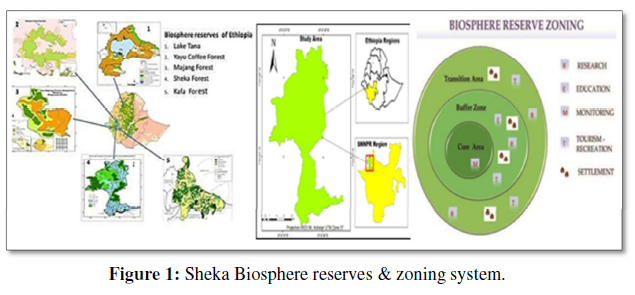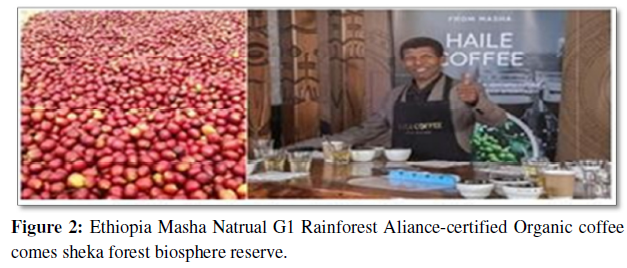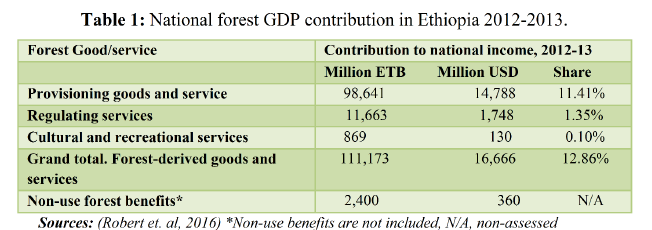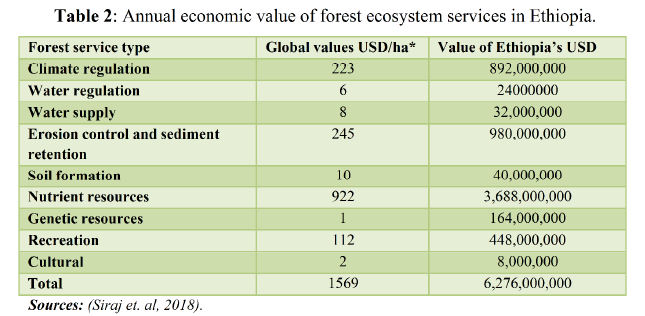Research Article
REVIEW ON, ECOTOURISM DEVELOPMENT AS TOOL FOR FUTUER ENVIRONMENTAL CONSERVATION AND ITS IMPLICATION TO COMMUNITY LIVELIHOODS, IN CASE OF SHEKA FOREST BIOSPHERE RESERVE, IN SOUTH WEST ETHIOPIA
4557
Views & Citations3557
Likes & Shares
A biosphere reserve is designed by UNESCO’s Man and the Biosphere. BRs are areas of terrestrial and coastal/marine ecosystems or a combination thereof which are internationally recognized within the framework of UNESCO’s Programme on Man and The Biosphere. BRs are living laboratories for sustainable development and represent learning centers for environmental and human adaptability. According to the current world network of BRs there are about 701 BRs in 124 countries including 24 trans-boundary sites are designated globally. Nowadays, Ethiopia has 5 BRs; namely Majang Forest BRs, Lake Tana BRs, Sheka Forest BRs, Kaffa Coffee Forest biosphere reserve and Yayu Coffee Forest BRs .Tourism is travel for recreational, leisure, education and training, visiting friends and relatives, shopping, transit, pilgrimages or business purposes. Tourism is travel for recreational, leisure, education and training, visiting friends and relatives, shopping, transit, pilgrimages or business purposes persons staying in places outside their usual environment for not less than 24 hours and not more than one consecutive year. Ecotourism is responsible travel to natural areas which conserves the environment and improves the welfare of local people. The findings revealed that, Sheka forest Biosphere reserve as well as other biospheres reserve in Ethiopia is endowed with attractive landscape scenery, fauna and flora and indigenous culture of the local community, which are the existing potentials for ecotourism development whereas, the current status of ecotourism activities is at lower stage as compared to its potentials. Ecotourism is one of the largest and potential industries in the world and as well as in Ethiopia today. Ethiopia has enormous ecotourism potential areas like 5 BRs which are registered under UNESCO, 21 national parks; 3wildlife sanctuaries; 3 wildlife reserves; 3 community conservation areas; 7 open hunting areas and 18 controlled hunting areas.
Keywords: Ecotourism, Community livelihood, Biosphere reserve, Conservation.
ABBREVIATIONS
BRs: Biosphere Reserves; FAO: Food and Agricultural Organization of the United States; MAB: Man and Biosphere Reserve; MELCA: Movement for Ecological Learning and Community Action; NABU: Nature and Biodiversity Conservation Union; NGO: Non-Governmental Organization; NTFP: Non Timber Forest Products; SNNP: Southern Nations, Nationalities and Peoples; TIES: the International Ecotourism Society; UNESCO: United Nations Educational, Scientific and Cultural Organization; USD: United States Dollar; WNBRs: World Network of Biosphere Reserves; WTO: World Trade Organization; LDCs: Lesser developed countries.
INTRODUCTION
General Context and Background
Biosphere reserves are sites established by countries and recognized by UNESCO's to balance b/n people and nature (Zur Heide, 2012; UNESCO, 1996; Murat, 2016). According to the current world network of BRs there are about 701 biosphere reserves in 124 countries, including 21 Transboundary sites. 79 BRs in 29 countries in Africa, 5 in Ethiopia, about 257 million people living in BRs worldwide and more than 4 million in Ethiopia (Ferreira, et al., 2020). The Sheka Forest Biosphere Reserve is part of Eastern Afromontane Biodiversity Hotspot and used to conserve bicultural diversity (Selemon, 2019).Challenges: illegal logging, investment, inaccessibility, dependency on East Afromontane Biodiversity Hotspot (Genetic pool of Coffea arabica). Ecotourism is non-smoke & responsible travel to natural areas which conserves the environment and improves the welfare of local people (Fakana, et al., 2019).
METHDOLOGY OF RIVEW
This chapter provides the concepts and definitions of BRs, ecotourism development, social- ecological resilience, challenges and opportunities gathered by reviewing more than 60 different related materials .so the materials which are deemed to be necessary for this review articles are included. More than 20 different articles’s done in ecotourism, biosphere reserve, forest conservation were evaluated and organized. The sheka forest biosphere reserve lies between 7024ˈ-7052ˈn la and 35013ˈ-35035ˈe lo, 676 km southwest of addis ababa. Thealtitude ranges between 900 and 2700 m above sea level and it receives a high amount of rainfall with an average of 1800–2200 mm annually. The Sheka Forest BRs covers a total area of 238,750 ha of forest, bamboo thickets, wetlands, agricultural land, rural settlements, and towns (Fakana, & mengist, 2019).
RESULTS AND CONCLUSION
Sheka Forest Biosphere Reserve
This review highlight to shows the Sheka forest biosphere reserves has endowed with wonderful ecotourism potential to attract international as well as domestic tourists, ecologists, researchers, higher educational students, environmentalist, exporters, film makers, drifters, naturalist and other segments of visitors towards its valuable biodiversity. Sheka Forest Biosphere Reserve are intended to fulfill 3 basic functions, a conservation, development and logistic function to local, national and global issues of conservation and development (UNESCO, 2010; Murat, 2016; Selemon, 2019).’Ecotourism can help BRs fulfill their responsibilities of balanced relationship between humans and Nature (UNESCO/MAB, 2002) (Figure 1).
Ecotourism in Ethiopia and Forest Conservation


Ecotourism globally, generates $77 billion in revenue. It is fastest growing travel industry, with a growth rate of 10-30% (Hogenson, 2017).
Ecotourism is one of the largest and potential industries in Ethiopia today since it has a unique biodiversity, topographic features and rich cultural resources (Bromhead et al., 2000, Selemon T, 2019).
Ecotourism has the potential to contribute to biodiversity conservation within and outside protected areas, as well as to promote community livelihoods (Shaw & Williams, 2002; Wahab & Pigram, 2000; Murat, 2016).
Ethiopia’s forest and BRs based ecotourism income estimated annual turnover more than USD 2.3 billion to the national economy (Mohammed, 2014). Biosphere in Ethiopia is the natural Coffee Forests with coffee bushes under the canopy of the high forest (zur heide, 2012). Ecotourism is an alternative form of the newest opportunities for income generation without destroying the environment (Manu, 2012) (Figure 2, 3) (Table 1).






(Fakana et. al., 2019) UNESCO sheka Biosphere Reserves have three equally important functions: 1) socio-economic development; 2) conservation of ecosystems; 3) research, monitoring and education. The value of Ethiopia's forest ecosystems based on the 4 million hectare of high forest is estimated to be 6,276,000,000 USD (Siraj, et. Al, 2018). The contribution of forest ecosystems to agriculture is valued at 6.77% of GDP and also the contribution of forest to industry is 3.8% (Table 2). In addition, 2.4 billion ETB was attributed to non- market benefits based on (Robert, et. al, 2016).


The major functions of ecotourism in poverty alleviations are creation of job opportunities, income generation from sales of local goods, benefit sharing from the local business activities, and collective income and infrastructure gains. Ethiopia is known for its enormous natural ecotourism potentials with its unique biodiversity composition, fauna and flora in biosphere reserves. The ecotourism industry plays significant role eradicating poverty, good image building, sharing best experiences and international communication. It is made up of attraction, accommodation and transport component. Ethiopia is known for its enormous natural ecotourism potentials with its unique biodiversity composition, fauna and flora in biosphere reserves. South west Ethiopia, is riches in natural forest and biodiversity, this area simply green land, because of form five biosphere reserve in Ethiopia four forest biospheres reserve founded only south west Ethiopia, Sheka forest biosphere reserve in SNNP region in Sheka zone, Total biosphere reserves according to (Ferreira et. al, 2020) 701 in 124 countries in world, 79 in 29 countries in Africa and 5 in Ethiopia. More than 257 million people living in Biosphere Reserves worldwide. Finally founding form this review is Ethiopia’s biosphere reserves intermesh of ecotourism as well as forest conservation management plan of policymakers was very week. From this what I understand Ethiopian government with biosphere stockholders participation both conservation and utilization is far apart each other. The practice of modern natural resource conservation activities is not well developed in the area. In addition to this, the current expansion of agricultural investment, other human induced factors and lack of infrastructures are some of threats for the feature sustainable natural resource management.
The increasing flow of tourists to southern Ethiopia for the sake of nature, availability of different tourist attractions in and around the Biosphere reserve and high national and international concern for tourism or ecotourism are the major opportunities for the development of ecotourism on Sheka Biosphere reserve.
In general, the study indicated that the presence of ecotourism potentials which will benefit the local communities while contributing sustainable natural resources management of the reserve.
WAY FOR WORD
Forest managers and policy makers must be recognize that quality Sheka forest BRs planning and management for ecotourism benefit. Enhancing promotion and marketing of existing the ecotourism potential of the Sheka forest BRs to attract various visitors from the different corners of the Ethiopia as well as world. Basic infrastructures are essential for ecotourism development attraction, accommodation and transportation of visitors, researchers and environmentalist. Providing alternative livelihood options form ecotourism in BRs helps to minimize the pressure on the forest resources degradation.
- Aref, F., Gill, S. & Aref, F. (2010). Tourism Development in Local Communities Community Development Approach. Journal of American Science 6(2): 151-161.
- Atlabchew, T. (2002). Sustainable Tourism Development. Paper presented on the tourism Symposium on Occasion of the World Tourism Day Sheraton Addis September 24.
- Bromhead, M., Bouzaher, A., Castro, G., Falconer, J., Hamilton, K., et.al. (2000). Natural Resources Management Draft for Discussion Regional and Individual Submissions.
- Dabour, N. (2003). Problems and Prospects of Sustainable Tourism Development in the OIC Countries Ecotourism. Journal of Economic Cooperation 24(1): 25-62.
- Drumm, A. & Moore, A. (2002). An Introduction to Ecotourism Planning. I. Arlington, U.S.A Gobena, A. (2008). Assessment of Ecotourism Potentials for Sustainable Natural Resources
- Management in and Around Abijata Shalla Lakes National Park in the Central Ethiopian Rift Valley. M.Sc. Thesis, Addis Ababa University, Environmental Science.
- Gormsen, X. (1999). The Role of Tourism in the Regional Economic Development in China.
- Regional Development Studies 5(5):116-119.
- Hogenson, S. (2017). The case for responsible travel Trends & Statistics. Center for Responsible Travel Washington DC www. Responsible travel. org.
- Isaac, M., & Conrad, J.W.K. (2012). Community Based Ecotourism and Livelihood Enhancement in Sirigu. Ghana International Journal of Humanities and Social Science 2(18) www.ijhssnet.co
- Jairus N., Koki. (2017).Contribution of Ecotourism towards Sustainable Livelihood of the Communities Living on Wasini Island Kwale County Kenya. Journal of Tourism and Hospitality Management 5(3):106-125.
- Kimmel, J. (1999). Ecotourism as Environmental Learning. Journal of Environmental Education 30(2): 40-44.
- krantz,L. (2001). The sustainable livelihood approach to poverty reduction Swedish international development cooperation agency for policy and socioeconomic analysis.
- Louis, M.P. (2007). Ecotourism in Namibia Opportunities for Conservation and Development.
- Md.Anowar, H., Rabiul, I., Chamhuri, S., Shaharuddin, (2010). Educational tourism and forest conservation: diversification for child education. Institute for environment and development (LESTARI) universiti kebangsaan malaysia 43600. Available online at: Www.sciencedirect.com
- Murat Özyavuz (2016). BRs World’s largest Science Technology & Medicine. www.intechopen.com.
- Okello, F. (2003). Tourism and Hospitality Management Ecotourism in Uganda a Case Study of the Mgahinga National Park. M.Sc. Thesis Graduate Business School of Economics and Commercial Law Göteborg University.
- ONeill, A. C. (2002). What Globalization Means For Ecotourism Managing Globalizations Impacts on Ecotourism in Developing Countries. Indian Journal of Global Legal Studies 9(2): 501-528.
- Richards, G. & Hall, D. (2003). Tourism and Sustainable Community Development Routledge London and New York.
- Robert, S., Kieran, M., Jessica, M., Corinna, R., & Arnout van, S. (2016). The contribution of forests to national income in Ethiopia and linkages with REDD+ United Nations Environment Programme Nairobi. UNREDD Programme MEFCC.
- Scheyvens, R. & Momsen, J.H. (2008). Tourism and Poverty Reduction Issues for Small Islands States. Tourism Geographies 10(1): 22-41.
- Selemon, T., Chiranjib, K., & Alemken, B. (2019). Ecotourism potentials of the majang forest BRs. gambella, south west Ethiopia. International Journal of Tourism & Hospitality 2395- 7654.
- Shaw, G. & Williams, A.M. (2002). Critical Issues in Tourism a Geographical Perspective 2nd Edition Black Well Oxford.
- Sindiga, I., (1999). Tourism and African Development Change and Challenge of Tourism in Kenya England Ashgate publishing company.
- Siraj, M., Zhang, K., Xiao, W., Bilal, A., Gemechu, S., et.al. (2018). Does participatory forest management save the remnant forest in Ethiopia Proceedings of the National Academy of Sciences India Section B Biological Sciences 88(1): 1-14.
- Strasdas, W. (2002). Ecotourism Training Manual for Protected Area Managers. German Foundation for International Development (DSE) Center for Food Rural Development and The Environment (ZEL) Feldafing and Zschortatu Germany.
- 524
- Tesfu .F, Weldemariam T. & Asersie. M. (2016). Impact of human activities on BRs A case study from Yayu BRs Southwest Ethiopia Ethiopian Biodiversity Institute Animal Biodiversity Directorate Addis Ababa Ethiopia.
- Tesema, B. (2008). Ethiopia USAID Launches Ecotourism Development Program
- TIES. (2003). What Is Ecotourism. The International Ecotourism Society. Available online at: Http://Www.Ecotourism.Org/Index2.Php?What-Is-Ecotourism
- Tisdell, C. (2003). Economic Aspects of Ecotourism: Wildlife-Based Tourism and Its Contribution to Nature. Sri Lankan Journal of Agricultural Economics 5(1): 83-95.
- Torres, R. & Momsen, J.H. (2004). Challenges and Potentials for Liking Tourism and Agriculture to Achieve Pro-Poor Tourism Objectives. Progress in Development Studies 4(4): 294-318.
- UNESCO. (2010). Lessons from BRs in the Asia-Pacific Region and a Way Forward A regional review of BRs in Asia and the Pacific to achieve sustainable development.
- UNESCO/MAB. (2002). Ecotourism and Sustainable Development in Biosphere Reserves Experiences and Prospects Workshop Summary Reports 54.
- Wunder, S. (1999). Promoting forest conservation through ecotourism income a case study from the Ecuadorian amazon region. Center for international forestry research. Available online at: http://www.cgiar.org/cifor .issn 0854-9818
- Worku, M. (2014. Traditional uses of nontimber forest products in southwest Ethiopia Opportunities and challenges for sustainable forest management. Journal of Agriculture and Environmental Sciences 1(1).
- Wahab, S. & Pigram, J.J. (2000). Tourism Development and Growth. The Challenge of Sustainability Routledge London.
- Wearing, S. & Neil, J. (1999). Ecotourism Impacts Potentials and Possibilities. 1st Ed Reed Educational and Professional Publishing Ltd Great Britain.
- WTO. (2002). Enhancing the Economic Benefits of Tourism for Local Communities and Poverty Alleviation World Tourism Organization Madrid Spain.
- WTO. (2008). Creating an Institutional Environment Conducive to Increased Foreign Investment and Sustainable Development. XII United Nations Conference on Trade and Development 20-25.
- zur heide, F. (2012). Feasibility study for a Lake Tana BRs Ethiopia. Available online at: Http://www.bfn.de/0502_skripten. Federal agency for nature conservation .d-53179 bonn, Germany





